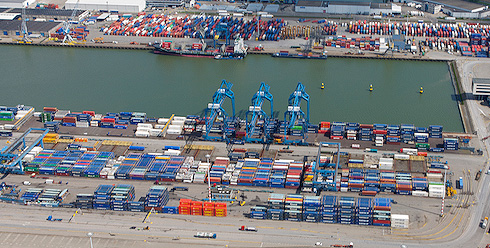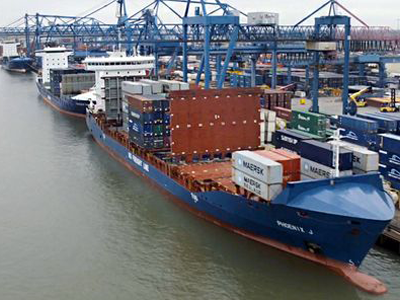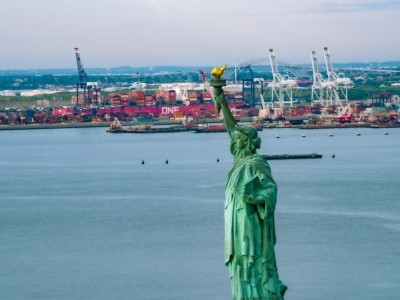Rotterdam Shortsea Terminals expect Brexit to drive more trans-channel freight onto container ships in 2021
Cees van Pelt, manager technical operations, Rotterdam Shortsea Terminals (RST) warned that post-Brexit maritime commerce between the UK and Europe is likely to face congestion and delays during the first half of 2021 resulting, at least temporarily, in more Trans-Channel freight being transported by container ships as opposed to rail and Ro/Ro (Roll On/Roll Off ships).
In the meantime, RST is moving to unload some ships by moving some crane operators from the crane cab to the RST office for remote operations claiming it saves time and money and reduces injuries.
In an interview with AJOT van Pelt said “The first week of the Brexit shows us that container traffic, but also Ro/Ro slowed down in the ports. The congestion is not seen yet but we expect that to come later in January 2021… We expect the delays due to paperwork deficiencies in 25% of the shipments going to the UK will cause increases in dwell times and perhaps added costs in handling. At the same time, we expect that these challenges in customs requirements will add time and cost to Ro/Ro business going on ferries and on trains, with the result that some of these moves will end up on containers to compensate for the higher cost. We expect that these issues will be resolved by the end of 2021. We are observing 7-10-hour delays right now processing containers as a result of the new customs paperwork requirements.“
Rotterdam Shortsea Terminals provides short sea shipping links for container driven cargoes from Rotterdam to European ports and to the United Kingdom.
RST had a throughput of 740,000 containers in 2019 and was projected to do 775,000 containers before Covid hit. It now projects 750,000 for 2020.

Innovative Wide Boom Crane Operations
RST has been an innovator in container handling. It deploys a wide boom container crane design. Cranes unload ships from the seaward side of piers onto stacks below the container crane. Once the ship departs, the crane operator re-directs the crane to the landside. The crane picks up containers below it in the stacks and then lowers the containers onto trucks moving on a lane alongside the cranes and stacks. The result is faster loading and unloading of vessels and quicker in and out times for truckers.
Remote Operations
At the same time, van Pelt notes that RST is expanding and moving crane operators off crane cabs and into the office to remotely load and unload ships:
“At RST, we have taken over the new ECT (Europe Container Terminals) terminal adjacent to RST and have integrated that into our shortsea operations. We have begun operating two of the cranes remotely, which means that we have moved the crane operator off the crane and into the office where the crane operator performs the same functions as they did on the crane, but now using cameras, is able to load and unload lorries and multitainers remotely. The vertical and horizontal axis of the cranes and crane rail expedite the remote operation of the STS (Ship To Shore) crane.”
The move does not cut worker wages, but saves money in time and less injuries. It will also allow people with disabilities to operate container cranes:
“In the case of remote operations, the operator is still paid the same but we have time savings in terms of lunch breaks, not requiring getting off and on cranes and injury- related problems related. From a time and injury perspective, moving the operator into the office is more cost effective and safer. In addition, we can now use disabled persons who are properly qualified to operate the remote system. “
Van Pelt added, “Remote operations with straddle carriers will take more time due to more varied trip routes in the stacks.”
There are regulatory and safety concerns related to moving to a totally automated container handling system: “The move to a totally automated system requires a number of safety protocols and is facing union resistance that has caused us to opt for the remote system instead… One of the issues is the visual resolution of cameras. It is not yet advanced enough to provide the type of precision that we need in order to operate safely and efficiently with an automated system. It may require another 10 years before the cameras reach the level of efficiency for scanners that will be optimum for an automated operation.”

Automation Challenges at Port of Rotterdam Maasvlakte Complex
Van Pelt says the Port of Rotterdam’s Maasvlakte container terminal complex features some automated container crane operations, but automated operations are not, as yet, as productive as worker operated cranes:
“At the same time, we are hearing that the automation on the Maasvlakte complex is not as productive as using manned crane operators. It is estimated that terminals using human crane operators … are as much as 40% more productive than the automated crane operations.”
Van Pelt notes several reasons for this:
The automated guided vehicles ((AGV) which remotely pick up and deliver containers to the cranes at the automated terminal are not keeping up with the rate of loading and unloading by crane operators, “So the cranes have to slow down to wait for the AGV to catch up…This is slowing down the process.”
The terminal operating systems (TOS) provided by terminal handling software companies do not efficiently accommodate exceptional boxes: “An exceptional box can be a tank container, a flat container, a 45-foot container. In these cases, the terminal has to stop its operation to manually move the exceptional box into and out of stacks at the terminal.”
The result is that in both of these cases, there is a reduction in productivity: “So, there are still a number of challenges that need to be faced before automation will work properly in STS crane operations.”
Similar Stories

Port of Seattle Statement on importance of industrial lands
View ArticleUAB-Online identifies key maritime industry trends
Stricter regulations, rapid technological advancements, and the global push for net-zero emissions are set to redefine maritime operations in Europe and the United States this year, in the viewpoint of…
View Article
Port of Los Angeles processed 10.3 million TEUs in 2024
View Article
Signal Marine Dry Weekly Market Monitor - Week 04.2025
View Article
Port Authority to outilne upcoming PATH Hoboken Station closure, detail alternate travel options
View ArticleMatson announces quarterly dividend of $0.34 per share
The Board of Directors of Matson, Inc. (NYSE: MATX), a leading U.S. carrier in the Pacific, today declared a first quarter dividend of $0.34 per common share. The dividend will…
View ArticleGet the most up-to-date trending news!
SubscribeIndustry updates and weekly newsletter direct to your inbox!





